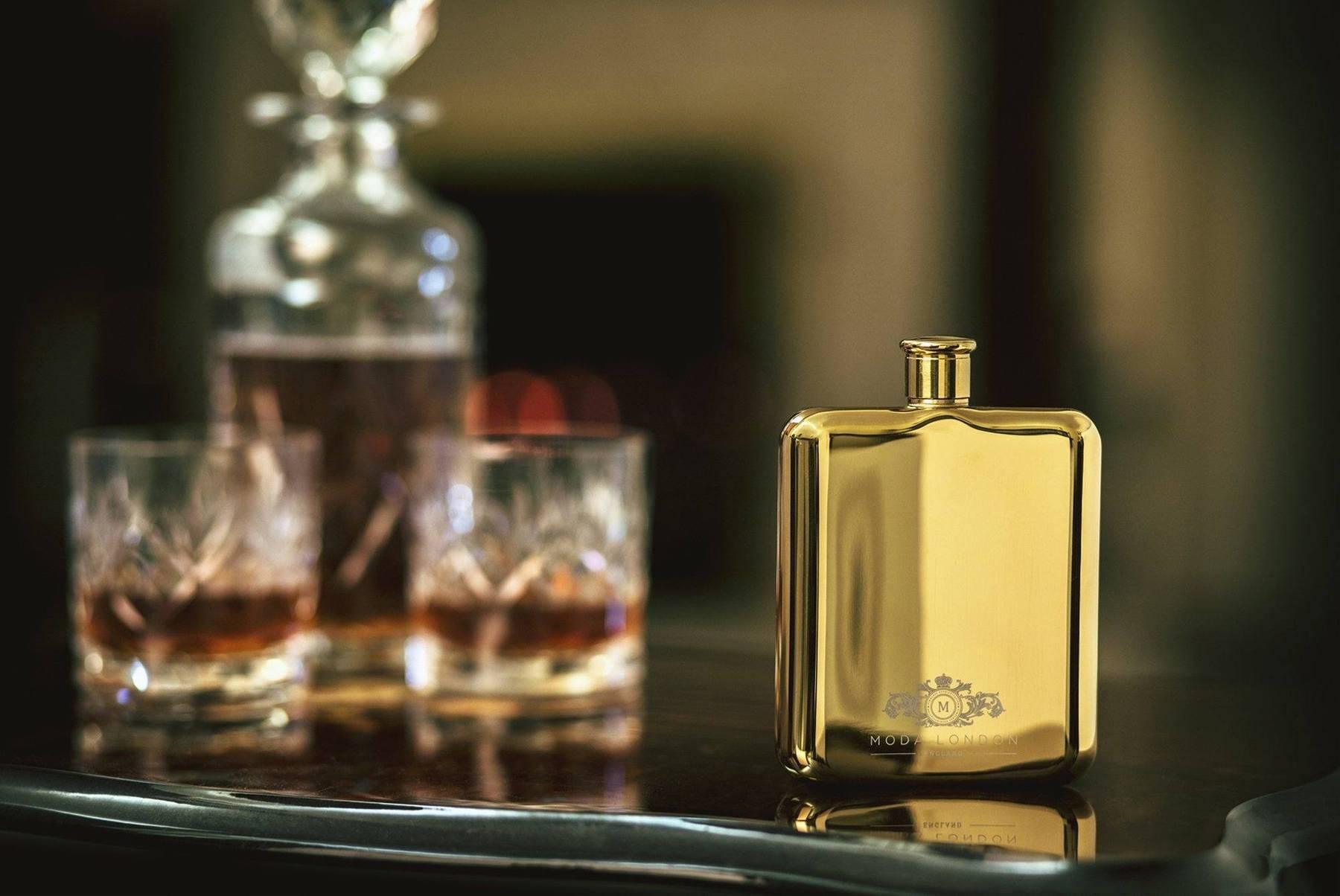There is no denying it, when you gently withdraw a
hip flask from your pocket and proceed to enjoy a sip or two of your favourite tipple, it’s the epitome of sophistication, a guilty pleasure that you can blissfully enjoy time and time again.
Article:

The Ultimate Hip Flask Buying and maintenance Guide
ORIGINS
USAGE
SELECTING THE RIGHT
HIP FLASK FOR YOU
Hip flasks come in a variety of sizes ranging from 3 to 8 ounces (around 90ml to 240ml). You’re sure to find one that meets all of your requirements whether it’s a smaller type for that long relaxing walk or hike or a larger vessel for that special sporting event.
FLASK MATERIALS
Hip flasks are available in several materials, such as stainless steel, pewter, plastic, glass and leather. Of these, stainless steel and pewter flasks are hugely popular. What’s more, these can be coated externally with gold, silver or copper to make them look even more attractive
STAINLESS STEEL
A stainless steel hip flask is a popular choice, let’s see why:
- Has an appealing polished exterior that is scratch proof and can retain its shine for many years.
- Its metal alloy body is rust and corrosion-resistant that keeps the contents safe and uncontaminated.
- Easy to clean and hygienic for use.
- Sturdy and strong enough to endure falls and withstand rough handling,
- making it ideal for everyday use.
- Comes in various shapes, sizes and colours and maybe embellished with
- different materials to make it more attractive.
- Costs a fraction of a pewter hip flask.
PEWTER
A solid pewter hip flask is much sought after for a number of reasons, let’s find out why:
- It combines practicality with style and has a finish that is superior to that of stainless steel
- Classic good looks and superior quality makes it a firm collectors’ item. Such quality flasks are usually handed down from one generation to another.
- Unlike some metals, pewter does not alter the taste characteristic of alcohol or imbue it with a metallic taste.
- A disadvantage of a pewter hip flask is its strength. Since it’s a soft metal compound it is prone to dents and scratches, stainless steel is much more hard-wearing.
-
Never use an antique pewter hip flask, as it may contain lead in its composition that can cause serious health issues and concerns.
However, modern-day pewter is generally lead-free and therefore more user friendly.
MAINTAINING YOUR HIP FLASK
Is it safe to leave alcohol in a hip flask?
Although a hip flask is meant to be emptied after every use, there are times when we may forget to empty the vessel.
The good news is that alcohol doesn’t spoil like some foods do. On the contrary, alcohol kills germs and bacteria.
However, as alcohol is a strong organic compound, it has a tendency to react with the internal surface of metal containers and can on occasion acquire a metallic taste.
Does this mean it is a complete no-no to leave alcohol in flask?
Not really, if you adhere to certain points:
- Remove alcohol after 24 hours or a maximum of 48 hours.
- During this period, store the flask in a cool dark place, doing so reduces the rate at which alcohol has the ability to acquire the taste of the flask material.
- Put the removed alcohol either back into its original bottle or in a clean glass container.
It is very important to clean a hip flask after every use.
This removes the risk of any alcoholic residue remaining in the flask.
Cleaning doesn’t consist of just rinsing with water, there are ways and means to clean a flask correctly. Let’s see how:
Cleaning Tips
Immediately after using the hip flask used for carrying alcohol, rinse it out thoroughly with water and leave off the screw cap. Invert the hip flask, and allow the flask to drain and dry out thoroughly before replacing the screw cap.
Never use soap, liquid or other detergents for rinsing the flask out. For one, the opening of the flask is too small to effectively rinse with soap, and second, there is a risk of soap residues remaining in the flask which may mix with alcohol and spoil its taste.
After every three uses, rinse your flask with a little white vinegar, followed by water. The vinegar reacts with residual alcohol molecules and removes them, thereby removing the taste altering elements.
CLEANING YOUR HIP FLASK –
A STEP BY STEP GUIDE
Repeat this process twice.
Note: take care when handling boiling hot water as the whole flask will become extremely hot.
Finally, fill the flask with boiling water to remove any
residual vinegar solution and pour it out.
Invert the flask on a paper towel to dry.
Once thoroughly dry, the hip flask is ready to be used again.
CONCLUSION
A hip flask is one of the most convenient and practical ways of carrying your favourite liquor to any destination. If you look after it well, clean it properly and regularly, it will provide you with many years of service and enjoyment.
If you want to check out more of our content, be sure to sign up for our blog updates!
As always, we're here to help make your big day as magical as possible. If you love personalising your whole event, consider purchasing our custom wedding cufflinks for your groom, best man, father, or brother.
We would also love it if you could share Moda London on your social media or with your friends and family!
FOR MORE INFORMATION ON ALCOHOL RESPONSIBILITY
Visit: responsibledrinking.org responsible drinking.eu and drinkaware.co.uk




